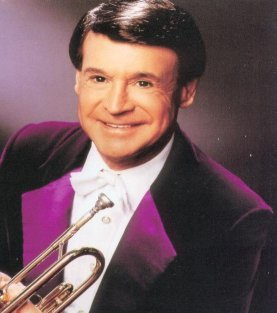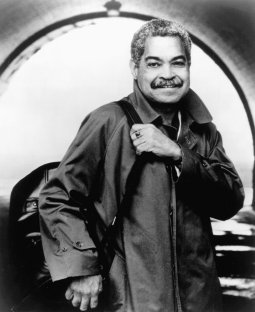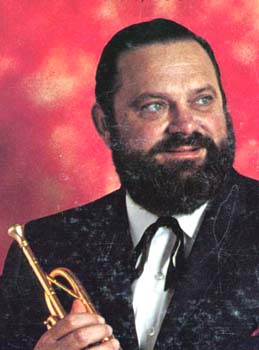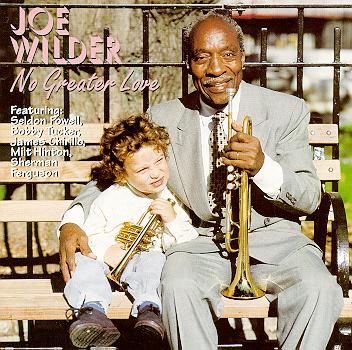Jazz
Trumpet Transcriptions

The Trumpet Kings
Of The Swing Era (and more)
by Jacques & Claude Gilbert
and theWoodwinds Website.
305 transcriptions available, 6 november 07.
+ 186 midifiles
This site is built with the aim of providing the young trumpet players with an opportunity to discover the treasures left by the preceding generations. A listening of the recordings is obviously essential and the necessary references are in general noted in the pdf. You will also find lot of midifiles from those transcriptions.
The "EJMA Woodwinds Website" cordially thanks Jacques Gilbert for having chosen it
to present this unique collection of transcriptions which he has compiled over a span of 50 years as an amateur instrumentalist. Claude Gilbert (a retired physician, pianist, saxophonist etc) is contributing with enthusiasm to this project by being a great help in the preparation of these rare files. It is hoped that this compilation will be favorably received by its target audience. This will be the most fitting reward for the pains that its contributors have taken with it. Let us take this opportunity to express our gratitude to them. The Webmaster: Charles SchneiderYou can read these documents with .

Jacques
Gilbert
Physicist by trade and amateur musician born in Quebec in
1932, Jacques Gilbert began playing trumpet in 1950 with a number of Montreal
big band formations of the era. He made his semi-professional debut with
the Al Nichols orchestra which was joined by the excellent Belgian guitarist
René Thomas as well as the well known Canadian jazz trumpet players
Guido Basso and Herbie Spaniar. In 1957 he establishes himself in Quebec
city where he continues to play for local bands making frequent stints with
the Roland Martel orchestra and taking part in many radio and television
broadcastings.
email
Jacques Gilbert : jgilb@videotron.ca
WARREN VACHE
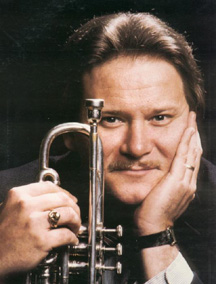
real name: Warren Vaché, Jr. Born Feb 21, 1951 in Rahway, NJ.
Several years before Wynton Marsalis gained headlines for helping to revive
hard bop, Warren Vache (along with Scott Hamilton) was among the few young
jazz musicians who were reviving small-group swing. Vache, who always had
a beautiful tone and a chance-taking style, is the son of a fine bassist (Warren
Vache Sr.) and the brother of clarinetist Allen Vache. He studied music with
Pee Wee Erwin; gained early experience playing with Benny Goodman, Vic Dickenson,
and Bob Wilber; and has been a leader since the mid-'70s. Often teamed in
his early years with tenorman Scott Hamilton, Vache recorded regularly and
has been a regular at jazz parties and swing-oriented festivals ever since.
— Scott Yanow, All Music
Guide
• Don't
miss the DVD "Warren
Vaché : I Love the Trumpet". From beginner
to advanced Lessons, to a History of the Jazz Trumpet, Warren Vaché
renowned jazz trumpeter, and charter member of the Juilliard School Program
for Jazz Studies, walks you through everything you need to know about the
trumpet.
A Beautiful Friendship
All Through The
Night
Autumn In New York
Bolden Blues midifile
Buddy Bolden's Blues
midifile
Close As Pages
In A Book
Exactly Like You
midifile
Darn That Dream midifile
I'm Old Fashioned
I Hadn't Anyone
Till You midifile
I Let A Song
Go Out Of My Heart midifile
If We Never Meet
Again midifile
It Might As
Well Be Spring
It's All Right
With Me midifile
It's Love In
The Spring midifile
It's You Or No One
Just Friends
Little Girl midifile
Little White Lies
midifile
Moten Swing midifile
My Melancholy Baby
midifile
Oh Baby
Out Of Nowhere midifile
Someday You'll
Be Sorry
Song Of The Wanderer
Struttin' With
Some BBQ
Summer Night
Taking A Chance
On Love
The More I See
You midifile
Too Close For Comfort
When
It's Sleepy Time Down South
Why Shouldn't I
You'd
Be So Nice midifile
Bix BEIDERBECKE

real name: Leon Bix Beiderbecke Born Mar 10, 1903 in Davenport, IA Died Aug
6, 1931 in New York, NY
Bix Beiderbecke was one of the greatest jazz musicians of the 1920s. His colorful
life, quick rise and fall, and eventual status as a martyr made him a legend
even before he died, and he has long stood as proof that not all the innovators
in jazz history were black. Possessor of a beautiful, distinctive tone and
a strikingly original improvising style, Beiderbecke's only competitor among
cornetists in the '20s was Louis Armstrong but (due to their different sounds
and styles) one really could not compare them.
Beiderbecke was a bit of a child prodigy, picking out tunes on the piano when
he was three. While he had conventional training on the piano, he taught himself
the cornet. Influenced by the original Dixieland Jazz Band, Beiderbecke craved
the freedom of jazz but his straight-laced parents felt he was being frivolous.
He was sent to Lake Forest Military Academy in 1921 but, by coincidence, it
was located fairly close to Chicago, the center of jazz at the time. Beiderbecke
was eventually expelled he missed so many classes. After a brief period at
home he became a full-time musician. In 1923, Beiderbecke became the star
cornetist of the Wolverines and a year later this spirited group made some
classic recordings.
In late 1924, Beiderbecke left the Wolverines to join Jean Goldkette's orchestra
but his inability to read music resulted in him losing the job. In 1925, he
spent time in Chicago and worked on his reading abilities. The following year
he spent time with Frankie Trumbauer's orchestra in St. Louis. Although already
an alcoholic, 1927 would be Beiderbecke's greatest year. He worked with Jean
Goldkette's orchestra (most of their records are unfortunately quite commercial),
recorded his piano masterpiece "In a Mist" (one of his four Debussy-inspired
originals), cut many classic sides with a small group headed by Trumbauer
(including his greatest solos: "Singin' the Blues," "I'm Comin'
Virginia," and "Way Down Yonder in New Orleans"), and then
signed up with Paul Whiteman's huge and prosperous orchestra. Although revisionist
historians would later claim that Whiteman's wide mixture of repertoire (much
of it outside of jazz) drove Beiderbecke to drink, he actually enjoyed the
prestige of being with the most popular band of the decade. Beiderbecke's
favorite personal solo was his written-out part on George Gershwin's "Concerto
in F."
With Whiteman, Beiderbecke's solos tended to be short moments of magic, sometimes
in odd settings; his brilliant chorus on "Sweet Sue" is a perfect
example. He was productive throughout 1928, but by the following year his
drinking really began to catch up with him. Beiderbecke had a breakdown, made
a comeback, and then in September 1929 was reluctantly sent back to Davenport
to recover. Unfortunately, Beiderbecke made a few sad records in 1930 before
his death at age 28. The bad liquor of the Prohibition era did him in.
For the full story, Bix: Man & Legend is a remarkably detailed book. Beiderbecke's
recordings (even the obscure ones) are continually in print, for his followers
believe that every note he played was special. — Scott Yanow All
Music Guide
I'm Coming
Virginia midifile
Jazz me Blues
midifile
Signin' The
Blues midifile
Riverboat Shuffle
midifile
Way
Down Yonder In New Orleans midifile
Mississipi
Mud midifile
ROY ELDRIDGE
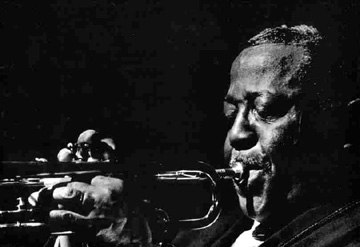
Portrait of Roy Eldridge, Spotlite (Club), New York,
N.Y., ca. Nov. 1946.
Gottlieb,
William P. 1917- photographer.
David Roy Eldridge. Born Jan 30, 1911 in Pittsburgh, PA. Died Feb 26, 1989
in Valley Stream, NY.
Roy Eldridge, trumpet-vocal; b. 1/30/11 Pittsburgh, PA; d. 2/26/89. Also known
as “Little Jazz” Roy Eldridge was a fiery, energetic trumpeter who
although short in stature was a larger-than-life figure in the jazz trumpet
lineage. Stylistically speaking he was the bridge between the towering trumpet
stylists Louis Armstrong and Dizzy Gillespie. One of a significant number
of jazz greats from the city of Pittsburgh, Roy’s first teacher was his
alto saxophonist older brother Joe. Some of the great rhythmic drive of Eldridge’s
later trumpet exploits could be traced to his beginnings on the drums, which
he began playing at age six. His first professional work came at age 16 when
he worked with a touring carnival, playing drums, trumpet, and tuba. As a
trumpeter Roy had come under the spell of Louis Armstrong’s irrisistable
style. Among his earliest band affiliations were Oliver Muldoon, Horace Henderson,
Zack Whyte, Speed Webb, and his own band, under the banner of Roy Elliott
and his Palais Royal Orchestra. In 1930 he made the move to New York and headed
straight to Harlem, where he gained work with a number of dance bands, among
which was the Teddy Hill band. He left New York in 1934 to join the Michigan-based
McKinney’s Cotton Pickers alongside such significant players as tenor
man Chu Berry. Roy returned to New York to rejoin Teddy Hill in 1935, with
whom he made his first recordings as a soloist in 1935. Prior to recording
with Hill he toured with the Connie’s Hot Chocolates revue. After he
left Hill’s band he became the lead trumpeter in Fletcher Henderson’s
orchestra where his upper register abilities were highlighted. It didn’t
take long for Eldridge to exert himself as a bandleader, forming his own octet
in 1936 in Chicago; a band which included his brother Joe.
Eldridge recorded with the Three Deuces group, then left music for a short
time to pursue radio engineering, an interesting twist considering his Chicago
group’s nightly radio broadcasts. By the end of the 1930s after freelancing
with such a wide array of bands Eldridge had gained notice as one of the swing
bands’ most potent soloists. In 1941 he joined drummer Gene Krupa’s
band. Not only did he provide trumpet fireworks for Krupa’s outfit he
also sang, recording a memorable duet with the band’s female singer,
Anita O’Day (NEA Jazz Master 1997) on the tune “Let Me Off Uptown”
in 1941. Later, after Krupa’s band disbanded in 1943, and a period of
freelancing, he toured with the Artie Shaw band in 1944. After Shaw it was
time for Roy to lead his own big band, though economics forced him back to
small swing groups.In 1948 Norman Granz recruited Eldridge for his Jazz at
the Philharmonic, an ideal situation for Roy since he was one of the ultimate
jam session trumpeters. He toured briefly with Benny Goodman and took up residence
in Paris in 1950, where he made some of his most successful recordings. He
returned to New York in 1951 and continued freelancing with small bands, including
work with Coleman Hawkins, Benny Carter, Ella Fitzgerald, and Johnny Hodges.
He made notable albums for Verve Records alongside Hawkins and continued freelancing
and leading a house band at Jimmy Ryan’s club in New York. In 1980 he
was felled by a stroke but that didn’t cut off his musicality. Disabled
from the rigorous demands of playing the trumpet, Eldridge continued to make
music as a singer and pianist until his 1989 passing.
Back
Home Again In Indiana midifile
Embraceable You
midifile
I Can't
Get Started With You
I'll
Always Be In Love With You midifile
I Only Have
Eyes For You
Memories Of You
midifile
Missisipi Mud
Rockin' Chair
midifile
Shine midifile
Somebody Loves Me
Stardust midifile
Stardust 2
Sweet Sue
Just You
Talk Of The
Town midifile
Trumpet Blues midifile
Wrap
Your Troubles In Dreams midifile
ERNIE ROYAL

Ernie Royal : A
Les Tomkins interview of 1978
Ernest Andrew Royal Born Feb 6, 1921 in Los Angeles, CA. Died Mar 16, 1983
in New York, NY.
A brilliant technician with a beautiful tone and a wide range, Ernie Royal
spent most of his career in the anonymous settings of studio bands, uplifting
the music but only gaining fame among those in the music industry. The younger
brother of altoist Marshall Royal (who was nine years older), the trumpeter
picked up early experience playing in Los Angeles with Les Hite's Orchestra
(1937-38) and with Cee Pee Johnson (1939). Both of the Royal brothers were
with Lionel Hampton's big band (1940-42) and Ernie Royal hit the famous screaming
high notes on the original Hampton version of "Flying Home."
After a period in the Army (1942-45), he worked in San Francisco with Vernon
Alley, in Los Angeles with Phil Moore and then spent much of 1946 with Count
Basie's Orchestra. Royal was a member of Woody Herman's Second Herd during
1947-49 and had short stints with Charlie Barnet and Duke Ellington. He played
in France with Jacques Helian's Orchestra, worked with Wardell Gray in 1952
and was with Stan Kenton's Orchestra twice (1953 and 1955). After becoming
a staff musician at ABC in 1957, Ernie Royal settled into the life of a well-respected
studio musician, appearing on a countless number of recordings but rarely
soloing. During his career he made few recordings as a leader; just ten titles
in Paris in 1950 (six were reissued as part of a Xanadu album) and an LP for
Urania in 1954. — Scott Yanow, All
Music Guide
When
Your Lover midifile
Taking
A Chance On Love midifile
CHET BAKER
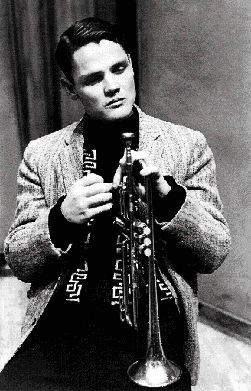
http://www.chetbaker.net/
Chesney Henry Baker, Jr. Born Dec 23, 1929 in Yale, OK. Died May 13, 1988
in Amsterdam, The Netherlands.
Popular cool-toned trumpeter and a fragile singer whose charisma made up for
his limited voice, with his good looks Chet Baker probably could have been
a movie star. Instead he became a drug addict in the mid-'50s and had an extremely
erratic lifestyle with horrific episodes alternating with some wonderful musical
moments.
Chet Baker certainly started out on top. After getting out of the Army, he
gigged with Charlie Parker on the West Coast in 1952 and then joined the Gerry
Mulligan Quartet, a pianoless unit that soon became among the most popular
in jazz. After Mulligan was jailed for his own drug problems, Baker (who had
helped make "My Funny Valentine" into a hit) formed a quartet with
pianist Russ Freeman. He began to win polls on both trumpet and vocals, toured
Europe in 1955 and seemed on his way to a lucrative career. But by 1960 Baker
was in an Italian jail and, although he made a few worthy recordings in the
'60s, by the end of the decade his teeth had been knocked out after a botched
drug deal and he was out of music.
Against all odds Chet Baker made a gradual comeback in the 1970s. Although
Baker recorded far too much during his final 15 years, his nomadic lifestyle
(never kicking drugs and essentially wandering all over Europe) was unstable
and his occasional vocals (always an acquired taste) were generally poor,
his trumpet playing actually improved as the decade progressed. In fact despite
everything, Chet Baker was still in his musical prime when he fell out of
a second story window (pushed or slipped?) to his death in 1988. He remains
one of the great cult figures of jazz. -- Scott Yanow, All
Music Guide
Almost
Like Being in Love
Autums In New York
midifile
Autums Leaves midifile
Band Aid
Bea's Flat
Blue Room midifile
But Not For Me Chet
midifile
Django
Happy Little
Sunbeam midifile
I Fall
In Love Too Easily midifile
I
Fall In Love Too Easily 2 midifile
In Your Own Sweet
Way (My Favorite songs)
In Your Own
Sweet Way (Legacy) midifile
It's You Or No One
Just Friends
Let's Get Lost
midifile
Long Ago And Far
Away midifile
Look For The
Silver Lining midifile
Maid In Mexico
Minor Yours midifile
No Ties
Out Of Nowhere
midifile
Pent Up House midifile
Polka Dots
And Moonbeams
Russ Job
Solar midifile
Star Eyes midifile
Stella By Starlight
midifile
Summertime midifile
Tangerine midifile
There'll
Never Be Another You midifile
There's A
Small Hotel
Time On My Hands
midifile
Well You Needn't
midifile
You Drive Me
Crazy
You Go To My Head
BOBBY HACKETT

Portrait of Bobby Hackett, Paramount Theater, New York, N.Y., ca. Aug. 1946.
Gottlieb,
William P. 1917- photographer.
Robert Leo Hackett Born Jan 31, 1915 in Providence, RI. Died Jun 7, 1976 in
Chatham, MA.
Bobby Hackett's mellow tone and melodic style offered a contrast to the brasher
Dixieland-oriented trumpeters. Emphasizing his middle-register and lyricism,
Hackett was a flexible soloist who actually sounded little like his main inspiration,
Louis Armstrong.
When Hackett first came up he was briefly known as "the new Bix"
because of the similarity in his approach to that of Bix Beiderbecke, but
very soon he developed his own distinctive sound. Originally a guitarist (which
he doubled on until the mid-'40s), Hackett performed in local bands, and by
1936 was leading his own group. He moved to New York in 1937, played with
Joe Marsala, appeared at Benny Goodman's 1938 Carnegie Hall concert (recreating
Beiderbecke's solo on "I'm Coming Virginia"), recorded with Eddie
Condon, and by 1939 had a short-lived big band. Hackett played briefly with
Horace Heidt, and during 1941-1942 was with Glenn Miller's Orchestra, taking
a famous solo on "String of Pearls." Next up was a stint with the
Casa Loma Orchestra, and then he became a studio musician while still appearing
with jazz groups. Hackett was a major asset at Louis Armstrong's 1947 Town
Hall Concert, in the 1950s he was a star on Jackie Gleason's commercial but
jazz-flavored mood music albums, and he recorded several times with Eddie
Condon and Jack Teagarden. During 1956-1957, Hackett led an unusual group
that sought to modernize Dixieland (using Dick Cary's arrangements and an
unusual instrumentation), but that band did not catch on. Hackett recorded
some commercial dates during 1959-1960 (including one set of Hawaiian songs
and another in which he was backed by pipe organ), he worked with Benny Goodman
(1962-1963); backed Tony Bennett in the mid-'60s; co-led a well-recorded quintet
with Vic Dickenson (1968-1970); and made sessions with Jim Cullum, the World's
Greatest Jazz Band, and even Dizzy Gillespie and Mary Lou Williams, remaining
active up until his death. Among the many labels Bobby Hackett recorded for
as a leader were Okeh (reissued by Epic), Commodore, Columbia, Epic, Capitol,
Sesac, Verve, Project 3, Chiaroscuro, Flying Dutchman, and Honey Dew. —
Scott Yanow, All Music Guide
After
You've Gone
A String Of Pearls
midifile
(sequenced by http://www.garyw0001.com/)
Baby
Won't You Please Come Home
Back Home
Again In Indiana
Basin Street Blues
Big Butter And
Eggman
Bill Bailey
C'est Magnifique
midifile
Cornet Chop Suey
Darn That Dream
Embraceable You
Embraceable
You (easy beat)
Fidgety Feet
From Monday On
High Society
How High The Moon
I'll
Be A Friend With Pleasure midifile
I Cried For You
If I Had My Way
midifile
In The Mood
midifile
Jazz Me Blues
Little Brown Jug
midifile
Moonlight Serenade
midifile
(sequenced by http://www.garyw0001.com/)
More Than You Know
midifile
Muskrat Ramble
My Monday Date
midifile
New Orleans
midifile
Poor
Butterfly
Royal Garden Blues
Satin Doll
Stardust
Someday You'll
Be Sorry
Little Brown Jug
Struttin'
With Some BBQ
Sunday midifile
Sugar Blues
midifile
Sweet
Georgia Brown midifile
Sweet
Georgia Brown (vers2) midifile
Sweet Lorraine
Sweet Sue Just You
midifile
Take The A Train
midifile
That's A Plenty
The Man I Love
midifile
The Girl From
Ipanema midifile
Tis Autumn midifile
Too Close For
Comfort
Way
Down Yonder In New Orleans
What's New
midifile
When
The Saints
Wolverine-Blues
BUCK CLAYTON
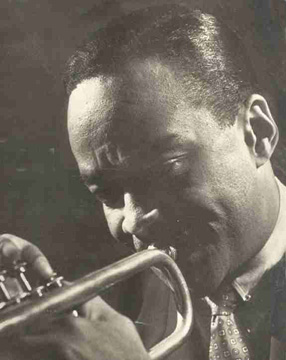
Special
Collections Wilbur "Buck" Clayton Collection at the Miller Nichols
Library at 5100 Rockhill Road in Kansas City, Missouri.
Wilbur Dorsey Clayton. Born Nov 12, 1911 in Parsons, KS. Died Dec 8, 1991
in New York, NY.
An excellent bandleader and accompanist for many vocalists, including Billie
Holiday, Buck Clayton was a valued soloist with Count Basie Orchestra during
the '30s and '40s, and later was a celebrated studio and jam session player,
writer, and arranger. His tart, striking tone and melodic dexterity were his
trademark, and Clayton provided several charts for Basie's orchestra and many
other groups. Clayton began his career in California, where he organized a
big band that had a residency in China in 1934. When he returned, Clayton
led a group and played with other local bands. During a 1936 visit to Kansas
City, he was invited to join Basie's orchestra as a replacement for Hot Lips
Page. Clayton was also featured on sessions with Lester Young, Teddy Wilson,
and Holiday in the late '30s. He remained in the Basie band until 1943, when
he left for army service. After leaving the army, Clayton did arrangements
for Basie, Benny Goodman, and Harry James before forming a sextet in the late
'40s. He toured Europe with this group in 1949 and 1950. Clayton continued
heading a combo during the '50s, and worked with Joe Bushkin, Tony Parenti,
and Jimmy Rushing, among others. He organized a series of outstanding recordings
for Columbia in the mid-'50s under the title Jam Session (compiled and reissued
by Mosaic in 1993). There were sessions with Rushing, Ruby Braff, and Nat
Pierce. Clayton led a combo with Coleman Hawkins and J.J. Johnson at the 1956
Newport Jazz Festival, then reunited with Goodman in 1957 at the Waldorf Astoria.
There was another European tour, this time with Mezz Mezzrow. He appeared
in the 1956 film The Benny Goodman Story and played the 1958 Brussels World
Fair with Sidney Bechet. Clayton later made another European visit with a
Newport Jazz Festival tour. He joined Eddie Condon's band in 1959, a year
after appearing in the film Jazz on a Summer's Day. Clayton toured Japan and
Australia with Condon's group in 1964, and continued to revisit Europe throughout
the '60s, often with Humphrey Lyttelton's band, while playing festivals across
the country. But lip and health problems virtually ended his playing career
in the late '60s. After a period outside of music, Clayton once again became
active in music, this time as a non-playing arranger, touring Africa as part
of a State Department series in 1977. He provided arrangements and compositions
for a 1974 Lyttleton and Buddy Tate album, and did more jam session albums
for Chiaroscuro in 1974 and 1975. He also became an educator, teaching at
Hunter College in the early '80s. Clayton led a group of Basie sidemen on
a European tour in 1983, then headed his own big band in 1987 that played
almost exclusively his compositions and arrangements. That same year Clayton's
extensive autobiography Buck Clayton's Jazz World, with Nancy Miller-Elliot,
was published. — Ron Wynn, All
Music Guide
I've
Got My Love To Keep Me Warm
I Cover The
Waterfront
Rosetta midifile
Tenderly
midifile
These Foolish Things
BUNNY BERIGAN

Bunny Berigan :"I love music but I hate the
music business".
Rowland Bernart Berrigan. Born Nov 2, 1908 in Hilbert, WI. Died Jun 2, 1942
in New York, NY.
Bunny Berigan, during 1935-1939, was arguably the top trumpeter in jazz (with
his main competition being Louis Armstrong and Roy Eldridge). Blessed with
a beautiful tone and a wide range (Berigan's low notes could be as memorable
as his upper-register shouts), Berigan brought excitement to every session
he appeared on. He was not afraid to take chances during his solos and could
be a bit reckless, but Berigan's successes and occasional failures were always
colorful to hear, at least until he drank it all away.
Bunny Berigan played in local bands and then college groups in the Midwest.
He tried out for Hal Kemp's orchestra unsuccessfully in 1928 (rejected because
of his thin tone, remarkably) but showed tremendous improvement by 1930 when
he was hired. After a few recordings and a trip to Europe, Berigan joined
Fred Rich's CBS studio band in 1931, where (except for a few months with Paul
Whiteman) he would remain up to 1935. Berigan soon gained a strong reputation
as a hot jazz soloist and he appeared on quite a few records with studio bands,
the Boswell Sisters, and the Dorsey Brothers. In 1935, he spent a few months
with Benny Goodman's orchestra, but that was enough to launch the swing era.
Berigan had classic solos on Goodman's first two hit records ("King Porter
Stomp" and "Sometimes I'm Happy") and was with B.G. as he went
on his historic tour out West, climaxing in the near riot at the Palomar Ballroom
in Los Angeles.
Berigan soon returned to the more lucrative studio scene, making his only
film appearance in 1936 with Fred Rich. In 1937, he joined Tommy Dorsey's
band and was once again largely responsible for two hits: "Marie"
and "Song of India." Berigan's solos on these tunes became so famous
that in future years Dorsey had them written out and orchestrated for the
full trumpet section. After leaving Dorsey, Bunny Berigan finally put together
his own orchestra. He scored early on with his biggest hit, "I Can't
Get Started." With Georgie Auld on tenor and Buddy Rich on drums, Berigan
had a potentially strong band. Unfortunately, he was already an alcoholic
and a reluctant businessman. By 1939, there had been many lost opportunities
and the following year Berigan (who was bankrupt) was forced to break up his
band. He re-joined Tommy Dorsey for a few months but never stopped drinking
and was not happy being a sideman again. Soon Berigan formed a new orchestra,
but his health began declining, and on June 2, 1942, he died when he was just
33. What would this brilliant swing trumpeter have done in the bop era?
Bunny Berigan's life is definitively profiled in Robert Dupuis' book Elusive
Legend of Jazz. — Scott Yanow, All
Music Guide
Ad-Lib Blues midifile
Ain't
She Sweet midifile
I
Can't Get Started With You
I'm Coming'
Virginia midifile
Let Yourself Go
midifile
Marie
On
Your Toes midifile
Song Of India
Stardust midifile
Sunday
midifile
Swanee River
midifile
CHARLIE SHAVERS
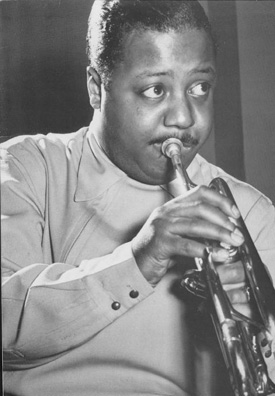
Portrait of Charlie Shavers, National studio, New York, N.Y., ca. May 1947.
Gottlieb,
William P. 1917- photographer.
Charles James Shavers. Born Aug 3, 1917 in New York, NY. Died Jul 8, 1971
in New York, NY
Charlie Shavers was one of the great trumpeters to emerge during the swing
era, a virtuoso with an open-minded and extroverted style along with a strong
sense of humor. He originally played piano and banjo before switching to trumpet,
and he developed very quickly. In 1935, he was with Tiny Bradshaw's band and
two years later he joined Lucky Millinder's big band. Soon afterward he became
a key member of John Kirby's Sextet where he showed his versatility by mostly
playing crisp solos while muted. Shavers was in demand for recording sessions
and participated on notable dates with New Orleans jazz pioneers Johnny Dodds,
Jimmy Noone, and Sidney Bechet. He also had many opportunities to write arrangements
for Kirby and had a major hit with his composition "Undecided."
After leaving Kirby in 1944, Charlie Shavers worked for a year with Raymond
Scott's CBS staff orchestra, and then was an important part of Tommy Dorsey's
Orchestra from 1945 until past TD's death in 1956. Although well-featured,
this association kept Shavers out of the spotlight of jazz, but fortunately
he did have occasional vacations in which he recorded with the Metronome All-Stars
and toured with Jazz at the Philharmonic; at the latter's concerts in 1953,
Shaver's trumpet battles with Roy Eldridge were quite exciting. After Dorsey's
death, Shavers often led his own quartet although he came back to the ghost
band from time to time. During the 1960s, his range and technique gradually
faded, and Charlie Shavers died from throat cancer in 1971 at the age of 53.
— Scott Yanow, All Music
Guide
A String Of Pearls
midifile
(sequenced by http://www.garyw0001.com/)
Blue Moon
midifile
Bye
Bye Blackbird
Deep Purple
Girl Of My Dreams
I'm Coming Virginia
I'm
Through With Love midifile
I Cover The
Waterfront
Our Love Is
Here To Stay midifile
Out Of Nowhere
Should I midifile
Time On My Hands
midifile
SHORTY ROGERS

Milton M. Rajonsky. Born Apr 14, 1924 in Great Barrington, MA. Died Nov 7,
1994 in Van Nuys, CA.
A fine middle-register trumpeter whose style seemed to practically define
"cool jazz," Shorty Rogers was actually more significant for his
arranging, both in jazz and in the movie studios. After gaining early experience
with Will Bradley and Red Norvo and serving in the military, Rogers rose to
fame as a member of Woody Herman's First and Second Herds (1945-1946 and 1947-1949),
and somehow he managed to bring some swing to the Stan Kenton Innovations
Orchestra (1950-1951), clearly enjoying writing for the stratospheric flights
of Maynard Ferguson. After that association ran its course, Rogers settled
in Los Angeles where he led his Giants (which ranged from a quintet to a nonet
and a big band) on a series of rewarding West Coast jazz-styled recordings
and wrote for the studios, helping greatly to bring jazz into the movies;
his scores for The Wild One and The Man With the Golden Arm are particularly
memorable. After 1962, Rogers stuck almost exclusively to writing for television
and films, but in 1982 he began a comeback in jazz. Rogers reorganized and
headed the Lighthouse All-Stars and, although his own playing was not quite
as strong as previously, he remained a welcome presence both in clubs and
recordings. — Scott Yanow, All
Music Guide
Left Bank
midifile
Lotus Bud
Shank's Pranks
Morpo midifile
CLIFFORD BROWN
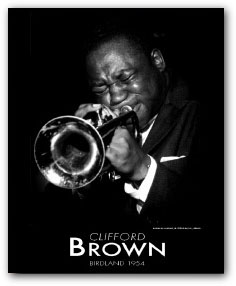
Clifford Brown's death in a car accident at the age of 25 was one of the great
tragedies in jazz history. Already ranking with Dizzy Gillespie and Miles
Davis as one of the top trumpeters in jazz, Brownie was still improving in
1956. Plus he was a clean liver and was not even driving; the up-and-coming
pianist Richie Powell and his wife (who was driving) also perished in the
crash.
Clifford Brown accomplished a great deal in the short time he had. He started
on trumpet when he was 15, and by 1948 was playing regularly in Philadelphia.
Fats Navarro, who was his main influence, encouraged Brown, as did Charlie
Parker and Dizzy Gillespie. After a year at Maryland State University, he
was in a serious car accident in June 1950 that put him out of action for
a year. In 1952, Brown made his recording debut with Chris Powell's Blue Flames
(an R&B group). The following year, he spent some time with Tadd Dameron,
and from August to December was with Lionel Hampton's band, touring Europe
and leading some recording sessions. In early 1954, he recorded some brilliant
solos at Birdland with Art Blakey's quintet (a band that directly preceded
the Jazz Messengers) and by mid-year had formed a quintet with Max Roach.
Considered one of the premiere hard bop bands, the group lasted until Brown's
death, featuring Harold Land (and later Sonny Rollins) on tenor and recording
several superb sets for Emarcy. Just hours before his death, Brownie appeared
at a Philadelphia jam session that was miraculously recorded, and played some
of the finest music of his short life.
Clifford Brown had a fat warm tone, a bop-ish style quite reminiscent of the
equally ill-fated Fats Navarro, and a mature improvising approach; he was
as inventive on melodic ballads as he was on rapid jams. Amazingly enough,
a filmed appearance of him playing two songs in 1955 on a Soupy Sales variety
show turned up after being lost for 40 years, the only known footage of the
great trumpeter. Fortunately, virtually all of his recordings are currently
available, including his Prestige dates (in the OJC series), his work for
Blue Note and Pacific Jazz (on a four-CD set), and his many Emarcy sessions
(reissued on a magnificent ten-disc set). But the one to pick up first is
Columbia's The Beginning and the End, which has Brown's first and last recordings.
All Music Guide
It
Might As Well Be Spring midifile
Once In
A While midifile
Pent Up House midifile
Stompin'
At The Savoy midifile
LEE MORGAN
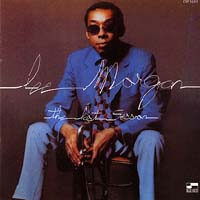
Trumpeter Lee Morgan's biting yet liquid delivery recalled the work of such
precursors as Clifford Brown and Fats Navarro, albeit with a harder edge.
A prodigious instrumentalist who made his first splash while still in his
teens, he became a leading hard bop and jazz-funk player; his composition
"The Sidewinder" was one of the biggest chart hits ever cut by a
jazzman.
Born July 10, 1938, Morgan was a product of Philadelphia's Mastbaum Tech,
which boasted a highly competitive music department that spawned other pros-to-be.
At the age of 18, he was starring in Dizzy Gillespie's band. After bowing
as a leader at 19 on Savoy, he began a fruitful relationship with Blue Note
Records. He fronted some all-star sessions, appeared as a sideman on such
memorable albums as John Coltrane's Blue Train, and made a stunning impression
with Art Blakey's Jazz Messengers (see Moanin'). After a return to Philadelphia
in the early '60s to fight a drug habit, Morgan came back in full effect,
first with the Messengers (sharing the stage with Wayne Shorter), then on
his own. In 1964, Morgan's The Sidewinder climbed to number 25 on Billboard's
pop album chart. Several ultra-funky sound-alikes followed, but Morgan may
have reached his creative peak on the ambitious, impressionistic 1964 set
Search For The New Land.
By the late '60s, even the titles of Morgan's records were beginning to sound
the same--The Rajah, The Procrastinator. However, as the '70s dawned, he began
to explore new terrain with a storming group that included saxophonist Bennie
Maupin. His full potential was still unfulfilled when he was fatally shot
to death by a spurned girlfriend on the bandstand of the New York club Slug's
on Feb. 19, 1972. He was only 33 years old. Large chunks of his work with
Blakey and as a leader have been compiled on stunning boxed sets by mail-order
label Mosaic Records. Chris Morris.
Blue Gardenia midifile
Ceora midifile
Hocus Pocus midifile
I Remember Clifford
midifile
Nica's Dream midifile
KENNY DORHAM
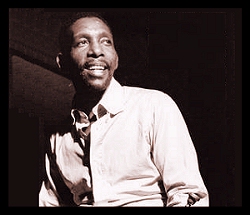
Real name: McKinley Howard Dorham. Born: Aug 30, 1924 in Fairfield, TX. Died:
Dec 5, 1972 in New York, NY
Throughout his career, Kenny Dorham was almost famous for being underrated
since he was consistently overshadowed by Dizzy Gillespie, Fats Navarro, Miles
Davis, Clifford Brown, and Lee Morgan. Dorham was never an influential force
himself but a talented bop-oriented trumpeter and an excellent composer who
played in some very significant bands. In 1945, he was in the orchestras of
Dizzy Gillespie and Billy Eckstine, he recorded with the Be Bop Boys in 1946,
and spent short periods with Lionel Hampton and Mercer Ellington. During 1948-1949,
Dorham was the trumpeter in the Charlie Parker Quintet. After some freelancing
in New York in 1954, he became a member of the first version of Art Blakey's
Jazz Messengers and for a short time led a group called the Jazz Prophets,
which recorded on Blue Note. After Clifford Brown's death, Dorham became his
replacement in the Max Roach Quintet (1956-1958) and then he led several groups
of his own. He recorded several fine dates for Riverside (including a vocal
album in 1958), New Jazz, and Time, but it is his Blue Note sessions of 1961-1964
that are among his finest. Dorham was an early booster of Joe Henderson (who
played with his group in 1963-1964). After the mid-'60s, Kenny Dorham (who
wrote some interesting reviews for Down Beat) began to fade and he died in
1972 of kidney disease. Among his many originals is one that became a standard,
"Blue Bossa." — Scott Yanow, All
Music Guide
Prince Albert
midifile
Recordame midifile
DON FAGERQUIST

Don Fagerquist
b. 6 February 1927, Worcester, Massachusetts, USA, d. 24 January 1974. After
working with the Mal Hallett band in the early '40s, Fagerquist joined Gene
Krupa in 1944. He stayed with Krupa for several years, comfortably adjusting
his trumpet playing to the boppish style the band adopted towards the end
of the decade. After Krupa's band folded Fagerquist spent a little time with
Artie Shaw before becoming a member of Woody Herman's Third Herd. He later
worked with Les Brown and the Dave Pell Octet, the Brown band's small-group
offshoot. A striking soloist, Fagerquist's thoughtful playing style admirably
suited the west coast scene and in the '50s he played extensively and sometimes
recorded with Shelly Manne, Pete Rugolo, Art Pepper and others, including
the popular big band assembled for record dates by Si Zentner in the mid-60s.
Brown's
Little Jug midifile
Crazy
Legs midifile
I'm
Forever Blowing Bubbles midifile
Jersey
Bounce midifile
Laura
midifile
Little
Brown Jug midifile
Our
Love Is Here To Stay midifile
LOUIS ARMSTRONG

Louis Armstrong House and
archives
Biographie
sur 'The Red Hot Jazz Archives'
Louis Daniel Armstrong. Born Aug 4, 1901 in New Orleans, LA. Died Jul
6, 1971 in New York, NY.
Ain't
Misbehaven midifile
A Monday Date midifile
Basin Street Blues midifile
Big Butter And Eggman
Blue
Again midifile
Blue
Turning Grey Over You midifile
Cakewalkin'
Babies From Home midifile
Cornet Chop
Suey
midifile
Dear
Old Southland midifile
Dinah
midifile
Down
In Honky Tonky Town midifile
Gully
Low Blues midifile
Heebies
Jeebies midifile
Hello
Dolly midifile
Home
midifile
Hotter
Than That midifile
I
Double Dare You midifile
If
I Could Be With You midifile
I'm
Confessing midifile
I'm
Not Rough midifile
Melancoly
Blues midifile
Muggles
midifile
Muskrat
Rumble
Potato
Head Blues
Some
Of Those Days midifile
Struttin'
With Some BBQ
Tight
Like This midifile
Weary
Blues midifile
West End Blues
Wild
Man Blues
Willie
The Weeper midifile
You're
Driving Me Crazy midifile
Vous pouvez
écouter quelques-unes de ces transcriptions sur le site ReHotJazz.
Ruby BRAFF

Born Mar 16, 1927 in Boston, MA.
One of the great swing/Dixieland cornetists, Ruby Braff went through long
periods of his career unable to find work because his music was considered
out-of-fashion, but his fortunes improved by the 1970s. A very expressive
player who in later years liked to build his solos up to a low note, Braff's
playing is instantly recognizable within seconds.
Braff mostly worked around Boston in the late '40s. He teamed up with Pee
Wee Russell when the clarinetist was making a comeback (they recorded live
for Savoy), and after moving to New York in 1953, he fit easily into a variety
of Dixieland and mainstream settings. Braff recorded for Vanguard as a leader,
and with Vic Dickenson, Buck Clayton, and Urbie Green. He was one of the
stars of Buck Clayton's Columbia jam sessions, and in the mid-'50s worked
with Benny Goodman. But, despite good reviews and occasional recordings,
work was hard for Braff to come by at times. In the 1960s, he was able to
get jobs by being with George Wein's Newport All-Stars and at jazz festivals,
but it was not until the cornetist formed a quartet with guitarist George
Barnes, in 1973, that he became more secure. Afterward, Braff was heard
in many small-group settings, including duets with Dick Hyman and Ellis
Larkins (he had first met up with the latter in the 1950s), quintets with
Scott Hamilton, and matching wits with Howard Alden. He remains one of the
greats of mainstream jazz. — Scott Yanow, All
Music Guide
If
I Could Be With You
It's
Wonderful
I've
Got the Feelin' I'm Fallin' midifile
Soft
Lights and Sweet Music midifile
(transcribe by Tim
Gill, thanks)
Don GOLDIE

Born Feb 5, 1930 in Newark, NJ. Died Nov 25, 1995 in Florida.
A talented soloist with a wide range, Don
Goldie was the son of longtime Paul Whiteman trumpeter Harry Goldfield.
Goldie performed with many types of groups, including with Buddy Rich and
the society band of Lester Lanin, before gaining prominence for his playing
with Jack Teagarden's Dixieland sextet (from 1959 until the trombonist's death
in 1964). Goldie eventually settled in Miami, where in the early '70s he recorded
11 albums for Jazz Forum, many of which were dedicated to the work of one
composer. A fixture in Miami clubs and hotels, Don Goldie committed suicide
in 1995. — Scott Yanow, All
Music Guide
Dick CATHCART

b. 6 November 1924, Michigan City, Indiana, USA, d. 8 November 1993, Woodland
Hills, California, USA.
Dick Cathcart played lead trumpet with Ray McKinley's first band after studying
at Indiana University. A stint with Alvino Ray's group and with the Air Force
followed. After the war he went with the revived Bob Crosby band, and from
there to studio work. His full-bodied trumpet work on the "Pete Kelly's
Blues" radio show with Jack Webb earned him the soundtrack cornet chore
in the motion picture of the same name.
Ballin'
the Jack midifile
Ida
Sweet as Apple Cider
Sugarfoot Strut
There'll
Be Some Changes Made
Doc CHEATHAM
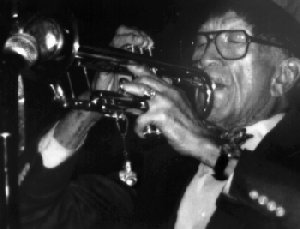
Doc Cheatham Autobiography
Adolphus Anthony Cheatham. Born Jun 13, 1905 in Nashville, TN. Died Jun
2, 1997 in Washington, D.C.
Doc Cheatham was without question the greatest 90-year old trumpeter of
all time; in fact, no brass player over the age of 80 had ever played with
his power, range, confidence, and melodic creativity. Most trumpeters fade
while in their 60s due to the physical difficulty of their instrument, but
Cheatham did not truly find himself as a soloist until he was nearly 70.
Doc Cheatham's career reaches back to the early '20s, when he played in
vaudeville theaters backing such traveling singers as Bessie Smith and Clara
Smith. He moved to Chicago, recorded with Ma Rainey (on soprano sax), played
with Albert Wynn, subbed for Louis Armstrong (his main idol), and had his
own group in 1926. After stints with Wilbur DeParis and Chick Webb, he toured
Europe with Sam Wooding. Due to his wide range and pretty tone, Cheatham
worked as a non-soloing first trumpeter with McKinney's Cotton Pickers and
Cab Calloway throughout the 1930s. He spent time with Teddy Wilson's big
band, and was with the commercially successful Eddie Heywood Sextet (backing
Billie Holiday on some recordings). In the 1950s, Cheatham alternated between
Dixieland (Wilbur DeParis, guest spots with Eddie Condon) and Latin bands
(Perez Prado, Herbie Mann). He was with Benny Goodman during 1966-1967,
but it was not until the mid-'70s that Cheatham felt truly comfortable as
a soloist. Duet sets with pianist Sammy Price launched his new career, and
until his death in 1997, he recorded fairly prolifically including dates
for Sackville, New York Jazz, Parkwood, Stash, GHB, Columbia, and several
European labels. Cheatham was also a charming singer whose half-spoken,
half-sung vocals took nothing away from his chance-taking trumpet flights.
— Scott Yanow, All
Music Guide
Rose Room
What
Can I Say After I'm Sorry
Shorty BAKER

Harold J. Baker. Born May 26, 1914 in St. Louis, MO. Died Nov 8, 1966 in New
York, NY.
Shorty Baker of the famous Saint-Louis school of trumpeters that starts with
Ed Allen and ends with Miles Davis and includes Joe Thomas and Clark Terry
was a player of exquisite taste. His frequents ins and outs with Duke Ellington
arose from his conviction (not unjustifiable) that Duke did not fully valued
his talents. However, Baker can be heard at length on a number of Ellington
performances and Duke especially appreciated his pretty sound and tasteful
phrasing on ballads. Among Baker's admirers was Miles Davis who had particular
praise for his tone and control.
Emmett BERRY
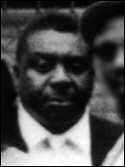
Emmett Berry (born 1916) is another trumpet player who has not received
due recognition from the public. Born in Macon, Georgia, he was raised in
Cleveland where he spent his early playing years. He joined Fletcher Henderson
in 1936, replacing his idol, Roy Eldridge, and did exceptionally well in
that demanding chair. After a stay with Teddy Wilson's sextet at Cafe Society,
Berry joined the CBS radio staff orchestra. From late 1945 to early 1950,
he was with Count Basie. Discouraged from the jazz scene and suffering from
mental depression, he then returned to Cleveland in 1970 where he soon became
inactive as a player.
CLARK TERRY

Born in St. Louis Dec 14, 1920 in St. Louis MO., Clark Terry performed
with Charlie Barnet (1947) and in Count Basie's big band and small groups
(1948-51) before beginning an important affiliation with Duke Ellington,
which lasted from 1951 to 1959. During this period Terry took part in
many of Ellington's suites and acquired a lasting reputation for his wide
range of styles (from swing to hard bop), technical proficiency, and infectious
good humor. After leaving Ellington he became a frequent performer in
New York studios and a staff member of NBC; he appeared regularly on the
Tonight Show, where his unique "mumbling" scat singing became
famous. He also continued to play jazz with musicians such as J.J. Johnson
and Oscar Peterson, and led a group with Bob Brookmeyer which achieved
some popularity in the early 1960s.
In the 1970s Terry began to concentrate increasingly on the flugelhorn
from which he obtains a remarkably full, ringing tone. In addition to
his studio work and teaching at jazz workshops, Terry toured regularly
in the 1980s with small groups (including Peterson's) and as the leader
of his Big B-A-D Band (formed 1970). His humor and command of jazz trumpet
styles are nowhere more apparent than in his "dialogues" with
himself, either on different instruments or on the same instument, muted
and unmuted. J. BRADFORD ROBINSON, The New Grove Dictionary of Jazz
HARRY JAMES
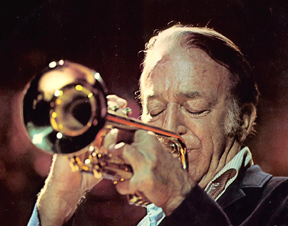
Harry James, real name: Harry Haag James. Born Mar 15, 1916 in Albany, GA.
Died Jul 5, 1983 in Las Vegas, NV
Trumpet
Blues: The Life of Harry James by Peter J. Levinson Published by Oxford
University Press 334 pages, 1999 ISBN: 0195110307
Harry James was one of the most outstanding instrumentalists of the swing
era, employing a bravura playing style that made his trumpet work instantly
identifiable. He was also one of the most popular bandleaders of the first
half of the 1940s, and he continued to lead his band until just before his
death, 40 years later. James was the child of circus performers. His father,
Everette Robert James, was the bandleader and trumpet player in the orchestra
for the Mighty Haag Circus, and his mother, Maybelle Stewart Clark James,
was an aerialist. Growing up in the circus, James became a performer himself
as early as the age of four, when he began working as a contortionist. He
soon turned to music, however, first playing the snare drum in the band from
about the age of six and taking trumpet lessons from his father. At 12, he
took over leadership of the second band in the Christy Brothers Circus, for
which his family was then working. He attended grade school in Beaumont, TX,
where the circus spent the winter, and when he was 14 he won a state music
contest as a trumpeter. That inspired him to turn professional and begin playing
in local bands. James' first job with a national band came in 1935 when he
was hired by Ben Pollack. In May 1935, he married singer Louise Tobin, with
whom he had two children and from whom he was divorced in June 1943. He made
his first recordings as a member of the Pollack band in September 1936. Not
long after, he was tapped by Benny Goodman, then leading one of the country's
most popular bands, and he began working for Goodman by the end of 1936. He
rapidly gained notice in the Goodman band, and by December 1937 he had begun
to make recordings under his own name for Brunswick Records (later absorbed
by Columbia Records). In early 1939, he left Goodman and launched his own
orchestra, premiering it in Philadelphia in February. That spring, he heard
the then-unknown Frank Sinatra on a radio broadcast and hired him ... Click
for more on allmusic.com.
Ad-Lib Blues
midifile
Cherry
Concerto
For Trumpet
Foot
Draggin' Blues midifile
I'm Confessin That I love
You midifile
It's The Dreamer
In Me midifile
Jalousie
midifile
Palladium Party
midifile
Roll 'Em
Sing Sing Sing
Sleepy Time Gal
That
Old Feeling midifile
Trumpet
Blues And Cantabile
You Go To My
Head midifile
JONAH JONES

Robert Elliott Jones. Born Dec 31, 1909 in Louisville, KY. Died Apr 30, 2000
in Manhattan, NY
A talented and flashy trumpeter, Jonah Jones hit upon a formula in 1955 that
made him a major attraction for a decade; playing concise versions of melodic
swing standards and show tunes muted with a quartet. But although the non-jazz
audience discovered Jones during the late '50s, he had already been a very
vital trumpeter for two decades. Jones started out playing on a Mississippi
riverboat in the 1920s. He freelanced in the Midwest (including with Horace
Henderson), was briefly with Jimmie Lunceford (1931), had an early stint with
Stuff Smith (1932-1934), and then spent time with Lil Armstrong's short-lived
orchestra and the declining McKinney's Cotton Pickers. Jones became famous
for his playing with Stuff Smith's Onyx club band (1936-1940), recording many
exciting solos. He gigged with Benny Carter and Fletcher Henderson and became
a star soloist with Cab Calloway (1941-1952), staying with the singer even
after his big band became a combo. Jones played Dixieland with Earl Hines
(1952-1953), toured Europe in 1954 (including a brilliant recording session
with Sidney Bechet), and then led his quartet at the Embers (1955), hitting
upon his very successful formula. His shuffle version of "On the Street
Where You Live" was the first of many hits and he recorded a long series
of popular albums for Capitol during 1957-1963, switching to Decca for a few
more quartet albums in 1965-1967. Jonah Jones recorded a fine date with Earl
Hines for Chiaroscuro (1972) and still played on an occasional basis in the
1980s and early '90s; he died April 30, 2000, at the age of 91. — Scott
Yanow, All Music Guide
Baubles
Bangles And Beads midifile
Rose Room
WILD BILL DAVISSON

William Stethen Davis born Jan 5, 1906 in Defiance, OH. Died Nov 14, 1989
in Santa Barbara, CA.
Wild Bill (William Edward) Davison was born in Defiance, Ohio on the 5th of
January 1906. Starting in the early 1920's he began to build his career with
various bands including Ben Meroff's Chicago-based orchestra (where he first
met guitarist Eddie Condon).
For most of the 1930's he was in Milwaukee, billed as "Trumpet King"
Davison, and despite a lip injury in 1939 (he was hit in the mouth, appropriately
for Milwaukee, by a flying beer mug) had arrived in New York by 1941. There
he worked in Nick's saloon and with an Original Dixieland Jazz Band re-creation
for the Katherine Dunham show which culminated in his recording 12 sides for
the Commodore label a week before his 38th birthday in 1944.
He recorded some brilliant sessions with George Brunis indicating he had finally
found his own style. In 1945 he joined Eddie Condon's house band, and those
long nights and hard musical pace at Condon's club made him a commanding front
man, a tough and reliable lead cornetist that Condon could count on; above
all an original.
Along with gold-standard Condon recordings and quartet dates of his own ,
by 1960 Davison was a soloist. Despite his regular reunions with Condon he
began a new lifetime pattern of bandleading and touring, appearing between
1965 and 1975 with over 100 bands and recording over 20 new albums. In England
he toured and recorded with Alex Welsh, Fred Hunt and Lennie Hastings, and
in the 1970's moved to Denmark. He was still globetrotting in 1983 and after
a short illness in 1983 played in the 1985 jazz festivals and toured England
in 1986. He died on November 14th 1989 at the age of 83.
KENNY BAKER
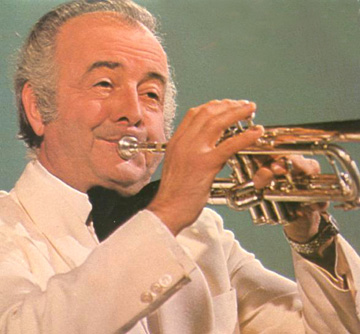
b. 1 March 1921, Withernsea, Yorkshire, England. After taking up the trumpet
and playing in brass bands, Baker moved to London, in the late '30s, to
become a professional musician. During the next few years he established
himself as an outstanding technician capable of playing in any jazz or dance
band. In the early '40s, he played in the bands of Lew Stone and George
Chisholm before joining Ted Heath in 1944. He remained with Heath until
1949, and was featured on many recording sessions and countless concerts.
In the early '50s he was regularly on the radio, leading his own band, the
Baker's Dozen, on a weekly late-night show which lasted throughout the decade.
In the '60s he led his own groups and recorded film soundtracks, all the
while building his reputation as one of the best trumpet players in the
world even though he played only rarely outside the UK. At the end of the
decade he was featured in Benny Goodman's British band. Baker's career continued
throughout the '70s, with appearances as co-leader of the Best of British
Jazz touring package, and with Ted Heath recreations and the bands led by
Don Lusher and other former colleagues. In the early '80s, Baker turned
down an invitation to take over leadership of the Harry James band after
the latter's death. He could still be regularly heard playing concerts and
club dates and was also on television, usually off-camera, playing soundtracks
for Alan Plater's popular UK television series THE BEIDERBECKE AFFAIR and
THE BEIDERBECKE TAPES. In 1989, he took part in a major recording undertaking
which set out to recreate the classic recordings of Louis Armstrong using
modern recording techniques. Baker took the Armstrong role, comfortably
confounding the date on his birth certificate with his masterful playing.
A fiery soloist with a remarkable technical capacity which he never uses
simply for effect, Baker is one of the UK's greatest contributions to the
international jazz scene.
When
It's Sleepy Time Down South midifile
BILLY BUTTERFIELD

Billy Butterfield b. 14 January 1917, Middleton, Ohio, USA, d. 18 March 1988.
As a child Butterfield was taught by cornetist Frank Simons, but as a teenager
he began to study medicine. He continued playing music to such good effect
that he was soon working regularly with the bands of Austin Wylie and Andy
Anderson and eventually quit his medical studies. Although adept on several
instruments he concentrated on trumpet, later adding fluegelhorn, and in 1937
was hired by the Bob Crosby band. Butterfield's gorgeous, fat-toned sound
was particularly suited to ballads and his recording of Bob Haggart's What's
New?, originally entitled I'm Free, was a hit. In 1940 he joined Artie Shaw,
then worked with Benny Goodman and Les Brown, but soon entered the more reliable
area of studio work. After the war Butterfield indulged himself with every
sideman's dream and formed his own big band, in collaboration with former
Crosby colleague Bill Stegmeyer. Butterfield took the enterprise seriously,
commissioning arrangements from Ralph Burns, Bob Haggart, Bob Peck and Neal
Hefti. For all his good intentions, however, the band proved to be a financial
disaster. For a while he returned to studio work but then began freelancing,
working with old comrades such as Eddie Condon, recording with Louis Armstrong
(playing the trumpet obbligato to Satchmo's vocal on the 1949 recording of
Blueberry Hill) and leading small groups. In the late '60s he became a member
of the World's Greatest Jazz Band alongside former Crosby sidemen Bob Haggart
and Yank Lawson. In the '70s he worked with Joe ‘Flip’ Phillips and toured
extensively, usually as a solo. Much admired by fellow musicians, and eventually
attracting the kind of attention from fans he had always deserved, Butterfield
enjoyed a late flowering of his career even though suffering from emphysema.
ZIGGY ELMAN
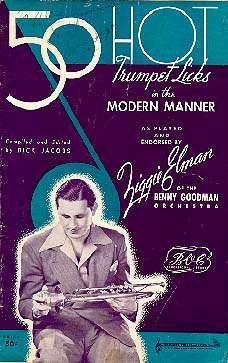
Ziggy Elman b. Harry Finkelman, 26 May 1914, Philadelphia, Pennsylvania, USA,
d. 26 June 1968. As a child Elman learned to play various brass and reed instruments,
and his first professional engagement was on trombone, although his main instrument
later became the trumpet. In 1936 he joined Benny Goodman and formed part
of one of the best three-man trumpet sections of the swing era. With Harry
James and Chris Griffin, Elman shared lead and solo duties and his dynamic,
biting playing was a great asset to the band. After James left to lead his
own band, Elman comfortably coped with his role as featured soloist, playing
showstoppers such as Who'll Buy My Bublitchki and And The Angels Sing, which
he composed himself. After leaving Goodman, Elman worked with other big bands,
including those of Joe Venuti and Tommy Dorsey. In the late '40s, as name
big bands were folding all around him, Elman tried leading his own big band
and met with a measure of success especially with a re-recording of And The
Angels Sing. In the early '50s he worked in film studios in Los Angeles but
ill-health and personal problems kept him from achieving much success. In
1961 his financial situation was revealed during an alimony court hearing
at which he agreed that many people thought him to be the world's greatest
trumpet player, adding ‘But I still can't get much work.’ Six of his seven
bank accounts had sums varying between $1.19 and $11.00 in them, while the
seventh was overdrawn.
And
The Angels Sing midifile
At Sundown midifile
My Blue Heaven
RANDY BROOKS

Randy Brooks
b. 28 March 1917, Maine, USA, d. 21 March 1967. A child prodigy, Brooks was
playing trumpet in Salvation Army bands when he was only 10 years of age.
In 1937 he travelled to New York to try his luck and soon found work with
Rudy Vallée: later he was a member of the bands of Hal Kemp and Claude
Thornhill. In the '40s he formed his own band and had record successes with
Tenderly and Harlem Nocturne. In 1945 his band accompanied Ella Fitzgerald
on two tracks recorded for Decca. Brooks, who married Ina Ray Hutton in 1949
(they divorced in 1957), suffered a stroke in 1950 which cut short his career.
He died in a fire at his home in March 1967.
The
Man With The Horn midifile
REX STEWART

Rex Stewart
William Stewart, Jr. Born Feb 22, 1907 in Philadelphia, PA, Died Sep 7, 1967
in Los Angeles, CARex Stewart achieved his greatest glory in a subsidiary
role, playing cornet 11 years in the Duke Ellington Orchestra. His famous
"talking" style, and half-valve effects were exploited brillantly
by countless Ellington pieces containing perfect passages tailored to showcase
Stewart's sound. He played in a forceful, gripping manner that reflected the
influence of Louis Armstrong, Bubber Miley and Bix Beiderbecke, whose solos
he once reproduced on record. Stewart played on Potomac riverboats before
moving to Philadelphia. He went to New York in 1921. Stewart worked with Elmer
Snowden in 1925, then joined Fletcher Henderson a year later. But he felt
his talents were not at the necessary level, and departed Henderson's band,
joining his brother Horace's band at Wilberforce College. Stewart returned
in 1928. He remained five years and contributed many memorable solos. There
was also a brief period in McKinney's Cotton Pickers in 1931, a stint heading
his own band, and another short stay with Luis Russell before Stewart joined
the Ellington Orchestra in 1934. He was a star throughout his tenure, co-writing
classics "Boy Meets Horn" and "Morning Glory." He also
supervised many outside recording sessions using Ellingtonians. After leaving,
Stewart led various combos, and performed throughout Europe and Australia
on an extensive Jazz at the Philharmonic tour from 1947-1951. He lectured
at the Paris Conservatory in 1948. Stewart settled in New Jersey to run a
farm in the early '50s. He was semi-retired, but found new success in the
media. He worked in local radio and television, while leading a band part
time in Boston. Stewart led the Fletcher Henderson reunion band in 1957 and
1958, and recorded with them. He played at Eddie Condon's club in 1958 and
1959, then moved to the West Coast. Stewart again worked as a disc jockey
and became a critic. - by Ron Wynn All
Music Guide
Between
The Devil And The Deep Blue Seaf midifile
I Surrender Dear
midifile
RAY ANTHONY
Ray Anthony played two years with Glenn Miller and ten with Jimmy Dorsey before forming his own band. Anthony led a group in the Pacific during World War II, then had a highly popular dance band. He probably has as much fame, if not more, as the writer of the theme for Dragnet, the novelty tune "The Bunny Hop," and the hit single "Dancing in the Dark." He also had plenty of film and TV work in the '50s, including an appearance in the film Daddy Long Legs. ~ Ron Wynn, All Music Guide
Lil'
Darlin'
Moonlight Serenade
midifile
(sequenced by http://www.garyw0001.com/)
DIZZY GILLESPIE
Dizzy GILLESPIE
real name: John Birks Gillespie
Born Oct 21, 1917 in Cheraw, SC
Died Jan 6, 1993 in Englewood, NJDizzy Gillespie's contributions to jazz were
huge. One of the greatest jazz trumpeters of all time (some would say the
best), Gillespie was such a complex player that his contemporaries ended up
copying Miles Davis and Fats Navarro instead, and it was not until Jon Faddis'
emergence in the 1970s that Dizzy's style was successfully recreated. Somehow,
Gillespie could make any "wrong" note fit, and harmonically he was
ahead of everyone in the 1940s, including Charlie Parker. Unlike Bird, Dizzy
was an enthusiastic teacher who wrote down his musical innovations and was
eager to explain them to the next generation, thereby insuring that bebop
would eventually become the foundation of jazz.All
Music Guide
Blue
Moon midifile
I Can't
Get Started midifile
I Don't
Know Why midifile
The Nearness
Of You midifile
ART FARMER
Art FARMER
real name: Arthur Stewart Farmer
Born Aug 21, 1928 in Council Bluffs, IA
Died Oct 4, 1999 in New York, NY
Largely overlooked during his formative years, Art Farmer's consistently inventive
playing was more greatly appreciated as he continued to develop. Along with
Clark Terry, Farmer helped to popularize the flugelhorn among brass players.
His lyricism gave his bop-oriented style its own personality. Farmer studied
piano, violin and tuba before settling on trumpet. He worked in Los Angeles
from 1945 on, performing regularly on Central Avenue and spending time in
the bands of Johnny Otis, Jay McShann, Roy Porter, Benny Carter and Gerald
Wilson among others; some of the groups also included his twin brother bassist
Addison Farmer (1928-63). After playing with Wardell Gray (1951-52) and touring
Europe with Lionel Hampton's big band (1953) Farmer moved to New York and
worked with Gigi Gryce (1954-56), Horace Silver's Quintet (1956-58) and the
Gerry Mulligan Quartet (1958-9). Farmer, who made many recordings in the latter
half of the 1950s (including with Quincy Jones and George Russell and on some
jam-session dates for Prestige) co-led the Jazztet with Benny Golson (1959-62)
and then had a group with Jim Hall (1962-64). He moved to Vienna in 1968 where
he joined the Austrian Radio Orchestra, worked with the Kenny Clarke-Francy
Boland Big Band and toured with his own units. Since the 1980s Farmer visited
the U.S. more often and has remained greatly in demand up until his death
on October 4, 1999. Farmer recorded many sessions as a leader through the
years including for Prestige, Contemporary, United Artists, Argo, Mercury,
Atlantic, Columbia, CTI, Soul Note, Optimism, Concord, Enja and Sweet Basil.
All Music Guide
Darn
That Dream midifile
Transcription : Sean-David McGoran
(thanks Sean)
Fair Weather midifile
I Love You midifile
I Remember
Clifford midifile
Whisper Not midifile
AL HIRT
Al Hirt
A virtuoso on the trumpet, Al Hirt was often "overqualified" for
the Dixieland and pop music that he performed. He studied classical trumpet
at the Cincinnati Conservatory (1940-1943) and was influenced by the playing
of Harry James. He freelanced in swing bands (including both Tommy and Jimmy
Dorsey, and Ray McKinley) before returning to New Orleans in the late '40s
and becoming involved in the Dixieland movement. He teamed up with clarinetist
Pete Fountain on an occasional basis from 1955 on, and became famous by the
end of the decade. An outstanding technician with a wide range, along with
a propensity for playing far too many notes, Hirt had some instrumental pop
hits in the 1960s. He also recorded swing and country music, but mostly stuck
to Dixieland in his live performances. He remained a household name throughout
his career, although one often feels that he could have done so much more
with his talent. Hirt's early Audiofidelity recordings (1958-1960) and collaborations
with Fountain are the most rewarding of his long career; he died at his home
in New Orleans on April 27, 1999. Biography by by Scott Yanow. All
Music Guide
The AL "He's the King" HIRT's page. Pictures, biography and discography of New Orlean's trumpet virtuoso by Carol.
Easy Street
Fools Rush In midifile
I Had The Craziest Dream midifile
Java midifile
That Old Feeling
When The Saints
midifile
DOC SEVERINSEN
born Jul 7,1927 in Arlington, OR.
Doc Severinsen, best known to late night television audiences as the Tonight
Show's flamboyant Grammy Award-winning musical director, has established a
multi-dimensional career beyond his late night repertoire, including symphonic
jazz and big band concert appearances, recordings, and commercials plus designing
and manufacturing trumpets.
Although Severinsen's signature has been his superb trumpet playing, quick witted banter and original style of clothes on the Tonight Show, he is one of today's pre-eminent instrumentalists. Today, Doc continues to tour across the country performing concerts in an array of musical styles - he performs classical and pop music as a guest conductor/performer with symphony orchestras. In addition to guest assignments, Doc is Principal Pops Conductor of the Phoenix Symphony, the Buffalo Philharmonic, the Minnesota Orchestra and the Milwaukee Symphony. Severinsen also plays sizzling jazz with his jazz group, Facets, and big band tunes with the famous former Tonight Show Band, now known as Doc Severinsen and His Big Band.
This summer, he's added a new dimension to his gifted repertory. Art Modell, owner of the Browns, thought their old Fight Song needed dusting off. Originally composed in the 1940's, the mascot tune had become out of step with the 90's. So, art turned to Doc. With a spiffy new arrangement, Doc has given the forty year old melody a new lease on life - an upbeat, very modern, jazzy rhythm.
Doc's big band tour of eleven cities up and down the Mississippi was completely
sold out. Doc conducted a fifteen member band, with some of the Tonight Show's
best - Ed Shaughnessy on drums, Ernie Watts on sax, and Chuck and Bob Finley
on trumpets. In March, 1996, Doc went to eight cities south of the Mason-Dixon
Line for a dashing tour of the Southern states
Georgia midifile
There'll
Never Be Another You midifile
JOE WILDER
Joe Wilder
b. Joseph Benjamin Wilder, 22 February 1922, Colwyn, Pennsylvania, USA. After
studying music in his home town, Wilder joined the trumpet section of the
Les Hite band in his late teens. From Hite he graduated to the Lionel Hampton
band and, before the 40s were over, had played with leaders such as Dizzy
Gillespie, Jimmie Lunceford, Lucky Millinder and Sam Donahue. In the 50s he
mostly worked in theatre bands but spent several months with Count Basie,
and by the end of the decade had embarked upon a long stint as a staff musician
in US radio and television studios. During this period, which extended into
the early 70s, he found time to play with Benny Goodman on a tour of the Soviet
Union. Later in the 70s and throughout the 80s he continued to play in studio
orchestras, making occasional recordings, including a fine set with Benny
Carter. In the 90s he returned as a leader and recorded two albums for Evening
Star. A top-rank lead trumpeter, Wilder's technical command has ensured his
successful career in the studios but that, in turn, has necessarily overshadowed
his jazz playing.
RAY COPELAND
Ray Copeland. Born Jul 17, 1926 in Norfolk, VA. Died May 18, 1984 in Sunderland,
MA
An accomplished composer and instructor, Ray Copeland was a solid trumpeter
from the '40s until the '80s in swing, bebop, hard bop and even with stage
bands. He gave many workshops and jazz history courses, and his playing demonstrated
a confident, engaging tone and crackling energy, as well as effective range
and timbre. Copeland studied classical trumpet and played with various rock
and pop groups as a teenager in Brooklyn. He toured in the late '40s with
Mercer Ellington and Al Cooper's Savoy Sultans. Copeland played with Andy
Kirk and Sy Oliver in the early '50s, and played bebop and swing with Lionel
Hampton, Randy Weston, Oscar Pettiford and others in the late '50s. He was
featured in the 1959 film "Kiss Her Goodbye." Copeland played in
The Roxy Theater Orchestra in the late '50s and early '60s, while also working
with Art Blakey, Cat Anderson, Johnny Richards, Louis Bellson and Pearl Bailey.
Copeland was one of Ella Fitzgerald's accompanists in 1965. He rejoined Weston
in 1966, and toured Africa on State Department-sponsored events in 1967 and
Morocco in 1970. He toured Europe with Thelonious Monk in 1968. Copeland played
at the 1973 Newport Jazz Festival and continued performing periodically into
the '80s. He also led orchestras in New York during the '70s, and his "Classical
Jazz Suite in Six Movements" composition premiered at the Lincoln Center
in 1970. Copeland worked in Broadway shows and toured Europe with the revue
"The Musical Life of Charlie Parker" in 1974. His book "The
Ray Copeland Method and Approach to the Creative Art of Jazz Improvisation"
was published that same year. Copeland didn't issue any dates as a leader,
but can be heard on various reissues by Monk, Weston, Blakey and Anderson.
Biography by Ron Wynn. All
Music Guide
MUGGSIE SPANIER
Real name : Francis Joseph Spanier. Born Nov 9, 1906 in Chicago, IL. Died
Feb 12, 1967 in Sausalito, CA
Muggsy Spanier was a predictable but forceful cornetist who rarely strayed
far from the melody. Perfectly at home in Dixieland ensembles, Spanier was
also an emotional soloist (equally influenced by King Oliver and Louis Armstrong)
who was an expert at using the plunger mute. He started on cornet when he
was 13, played with Elmer Schoebel's band in 1921, and first recorded in 1924.
Spanier was a fixture in Chicago throughout the decade (appearing on several
important early records) before joining Ted Lewis in 1929. Although Lewis
was essentially a corny showman, Spanier's solos gave his band some validity
during the next seven years. After a stint with Ben Pollack's orchestra (1936-1938),
Spanier became seriously ill and was hospitalized for three months. After
he recovered, the cornetist formed his famous eight-piece "Ragtime Band"
and recorded 16 Dixieland performances for Bluebird (later dubbed The Great
Sixteen) that virtually defined the music of the Dixieland revival movement.
But because his group actually preceded the revival by a couple years, it
soon had to break up due to lack of work. Muggsy joined Bob Crosby for a time,
had his own short-lived big band, freelanced with Dixieland bands in New York,
and starting in 1950 he gradually relocated to the West Coast. During 1957-1959
Spanier worked with Earl Hines' band and he continued playing up until his
retirement in 1964, touring Europe in 1960 and always retaining his popularity
in the Dixieland world. By Scott Yanow. All
Music Guide
2 GOOD LINKS :
Jeff Helgesen's Transcription Page - features transcriptions, bios, links, articles
JazzTrumpetSolos.com - features transcriptions, Jazz Forum , Jazz Radio, Bookmark JTS, etc
©Made by Jacques Gilbert & Claude Gilbert.
http://pubcs.free.fr/jg/jazz_trumpet_transcriptions_jacques_gilbert.html
email
Jacques Gilbert : jgilb@videotron.ca
